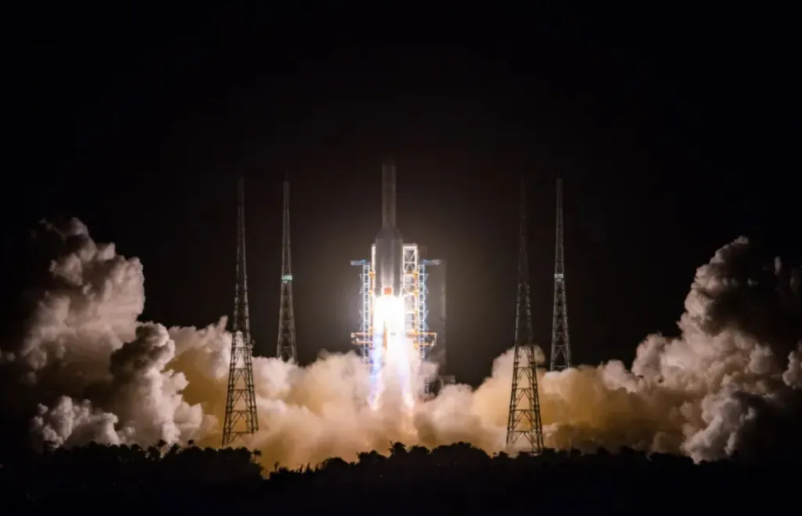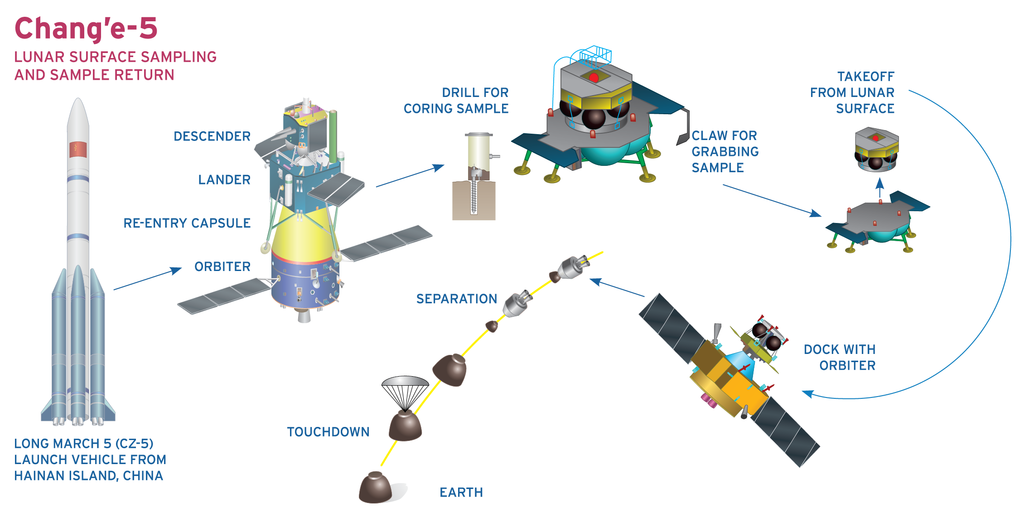
China's space program has been steadily advancing, with increasing sophistication in its exploration of outer space. In recent years, China has made remarkable strides in space exploration, and one of the most significant milestones in this journey has been its ambitious mission to the Moon. China's rocket to the Moon represents the nation's desire to not only solidify its position as a global space leader but also to unlock the mysteries of the Moon and beyond. This article will explore China's lunar missions, the technological advancements involved, the strategic motivations behind these endeavors, and the broader implications of China's ambitions in space.
The Rise of China's Space Program
China's space program, under the aegis of the China National Space Administration (CNSA), has evolved from its nascent stages in the 1950s to the present day, with a combination of international collaborations and homegrown innovations. The nation's ambition to become a dominant spacefaring power is underscored by its increasing investment in space technology, research, and exploration.
In the 2000s, China began to build its space station, develop sophisticated satellites, and launch manned space missions. Its lunar exploration program is a central part of this development. The first significant milestone came in 2007, when China successfully launched its first lunar probe, Chang'e 1. This spacecraft, named after the Chinese Moon goddess Chang'e, marked the beginning of China's concerted efforts to explore the Moon, laying the foundation for later lunar missions.
Key Milestones of China's Lunar Missions
China's lunar missions, often labeled under the Chang'e program, have been notable for their ambition and technological prowess. The Chang'e missions have not only focused on exploration but also on creating a sustainable presence on the Moon.
1. Chang'e 1 and Chang'e 2: The Pioneering Years
In 2007, the Chang'e 1 spacecraft was launched to the Moon, marking China's entry into lunar exploration. The mission was successful in mapping the lunar surface and conducting scientific observations. It orbited the Moon for over a year before being decommissioned.
Chang'e 2 followed in 2010, continuing the work of its predecessor. It was designed to perform high-resolution mapping of the Moon and test some of the technologies for future lunar landings. It also took the first images of the Moon's far side, a major achievement that highlighted China's ability to carry out complex space missions.
2. Chang'e 3: The First Lunar Landing
In December 2013, Chang'e 3 achieved a historic milestone as it successfully landed on the Moon's surface. This was China's first lunar soft-landing mission. The spacecraft delivered a lander and a rover, named Yutu, which means "Jade Rabbit." Yutu was tasked with exploring the lunar surface, analyzing soil composition, and studying the Moon's geology.
The success of Chang'e 3 demonstrated China's growing capabilities in space exploration, marking a significant achievement in the country's space program. However, the mission was not without challenges. The Yutu rover experienced technical problems, but it continued to operate for a number of years, contributing valuable data about the Moon's surface.
3. Chang'e 4: The First Soft Landing on the Far Side of the Moon
Perhaps one of the most groundbreaking missions in China's lunar program came in January 2019 with the launch of Chang'e 4. This mission achieved a historic first - the first soft landing on the far side of the Moon, a region that faces away from Earth and is inaccessible by direct radio communication.
The mission was designed to answer questions about the Moon's geological history and to conduct experiments on lunar soil, as well as to test new technologies that could be used in future space missions. The Chang'e 4 spacecraft carried both a lander and the Yutu-2 rover, which performed successful explorations and transmitted data back to Earth.
The Chang'e 4 mission was a breakthrough in space exploration, positioning China as a leader in space technology. The far side of the Moon had never been explored by any spacecraft, and this achievement highlighted China's increasing technological sophistication and its ability to innovate in challenging environments.
4. Chang'e 5: A Major Step Toward Lunar Sample Return
In December 2020, China achieved yet another remarkable feat with the successful launch of Chang'e 5. This mission marked the first lunar sample return since the 1970s when the Soviet Union's Luna program returned soil from the Moon. Chang'e 5 collected lunar soil samples from the Oceanus Procellarum region of the Moon and safely returned them to Earth, making China only the third nation in history (after the United States and the Soviet Union) to successfully return lunar samples.
The samples returned by Chang'e 5 are crucial for scientists to better understand the Moon's composition, geological processes, and the history of the Solar System. This mission has solidified China's position as a major player in the field of space exploration.
Technological Innovations Behind China's Moon Rocket
China's ability to reach the Moon and successfully conduct lunar exploration is the result of years of technological development, innovation, and a series of ambitious engineering projects. Several key technological advancements have been central to China's lunar missions, especially in terms of launching rockets and space transportation.

1. Long March Rocket Series
The backbone of China's space exploration missions, including its lunar missions, is the Long March rocket series. Developed by China's Academy of Launch Vehicle Technology (CALT), the Long March rockets have been the primary vehicles for launching satellites, lunar probes, and crewed missions. These rockets are named after the Long March of the Chinese Red Army during the Chinese Civil War.
The Long March 3B rocket, for example, was used for the launch of the Chang'e 3 lunar mission, while the more powerful Long March 5 was used for the Chang'e 5 mission. These rockets are notable for their reliability and efficiency, making them crucial to China's space ambitions. The Long March rockets are often seen as a symbol of China's technical progress and its growing self-sufficiency in space exploration.
2. Advanced Landers and Rovers
Another major technological advancement is China's development of advanced landers and rovers, which have been essential for lunar exploration. The Chang'e 3 lander and Yutu rover, for instance, used cutting-edge technology to land safely on the Moon and carry out a range of scientific experiments. These rovers were equipped with advanced cameras, spectrometers, and other scientific instruments to analyze the lunar soil and rocks.
The Chang'e 4 mission saw even further advancements, with the Yutu-2 rover being equipped with a suite of instruments to study the far side of the Moon. These advancements are laying the groundwork for future missions, such as those aimed at building a lunar base or conducting deeper geological investigations.
3. Sample Return Technology
The Chang'e 5 mission, in particular, highlighted China's advanced capabilities in space science and technology. The lander was able to collect lunar soil samples using a robotic arm, and a small spacecraft was launched to bring those samples back to Earth. This technology had not been used by any nation for lunar missions since the 1970s and was a major technical achievement for China.
The successful return of samples also involved the development of high-precision landing technology and the creation of a re-entry capsule that could safely return the samples to Earth. This sophisticated engineering demonstrated China's growing space capabilities.
The Strategic Motivations Behind China's Lunar Ambitions
China's push to land a rocket on the Moon and achieve further space exploration is not solely driven by scientific curiosity. There are several strategic, political, and economic motivations that are central to the country's lunar ambitions.
1. Technological Leadership
China is seeking to position itself as a technological leader in the 21st century. Space exploration provides a platform for China to showcase its scientific and engineering capabilities. By sending rockets to the Moon, China not only asserts itself as a spacefaring nation but also demonstrates its capacity for complex, cutting-edge technology development.
2. National Prestige
The lunar missions play a role in enhancing China's national prestige. As the world's most populous country and the second-largest economy, China's space program is a symbol of its increasing global influence. Lunar exploration, with its historic achievements and technological prowess, offers China a platform to further project its status as a superpower on the world stage.
3. Military and Strategic Advantage
Space exploration, especially lunar exploration, has long been linked with military and strategic advantages. Lunar resources, such as helium-3 (a potential fuel for nuclear fusion), could be of strategic importance in the future. By gaining control of space exploration, China seeks to secure an advantageous position in future resource competition and strengthen its military capabilities in space.
4. Sustainability in Space
China's lunar program also aligns with its long-term goal of establishing a sustained presence in space. Missions such as those planned for a lunar research base and the potential mining of lunar resources point toward China's ambition of building infrastructure beyond Earth. In the long run, the Moon could serve as a stepping stone for even more ambitious missions, such as Mars exploration or even deep space exploration.
The Future of China's Lunar Exploration
As China continues to advance in its lunar exploration endeavors, it has set its sights on even more ambitious goals. The country has plans for future missions that include building a lunar research station, as well as working toward the eventual goal of manned lunar missions.
China's vision for lunar exploration also includes the prospect of establishing a permanent presence on the Moon. In collaboration with other countries and international organizations, China is looking to build a scientific research station on the Moon by the 2030s. This station would serve as a hub for studying lunar resources, conducting scientific research, and testing technologies for future space missions.
The next significant milestone for China is its planned crewed lunar landing, which is expected to take place by the mid-2030s. This mission would be China's first human mission to the Moon and would solidify its position as a major player in the global space exploration community.
Conclusion
China's lunar ambitions are a testament to its rapid rise as a spacefaring nation. The successful missions carried out by the CNSA have made significant contributions to lunar exploration, and the country's ongoing plans for future missions point to an exciting era of space exploration. China's achievements, particularly its soft landing on the far side of the Moon and its sample return mission, underscore the country's technological innovation and global aspirations. The nation's lunar program is not only about science but also about geopolitical positioning, technological leadership, and the pursuit of long-term space sustainability. As China continues to push the boundaries of space exploration, it will undoubtedly play an increasingly prominent role in humanity's exploration of the Moon and beyond.
You can learn these concepts and more at Dr Hock's maths and physics tuition.